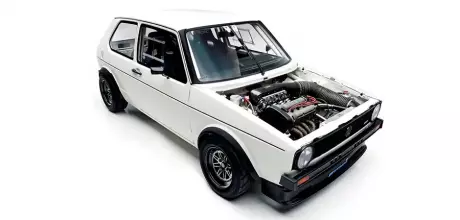770kg seam-welded 1980 Volkswagen Golf Mk1 with 206hp 16v motor
In the relentless pursuit of power-to-weight saving, Frank Wolkers set out his goal to build a sub-700kg Mk1 track car. Here’s how he did it.
Words: Chris Eyre
Photos: Lennart Dijkstra
LESS IS MORE
A sub-700 kilogram Mk1? Hot take: the welded in multi-point cage isn’t making this look easy, and the panels don’t look like wafer-thin fibreglass. Good luck with that.
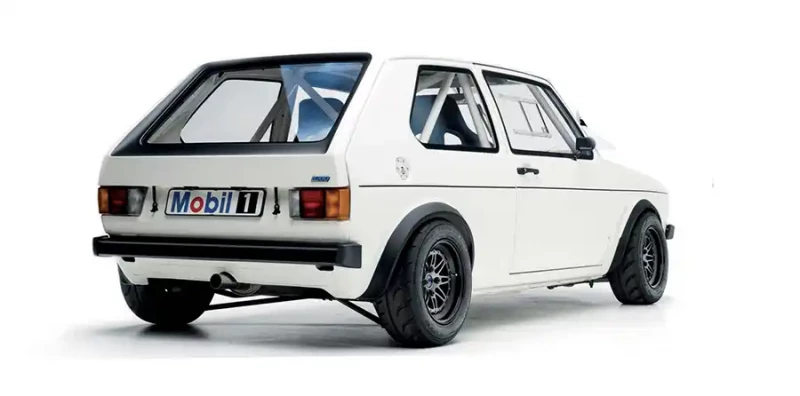
Usually very early bodyshells lend themselves to the featherweight game — or savagely gutted ones — or someone talking the talk! But not this one, as it turns out. Netherlands-based Frank Wolkers was serious from the very start. In September 2008 an unsuspecting — and complete — Inari Silver small light 1980, believed rust-free 1272cc three-door runner went on the weigh bridge at 770kg, and then straight into disassembly. Call the cage + 50 kg. The challenge then was to net throw out 120+ kgs out to hit the target. Could be interesting. Let’s do the ‘math’...
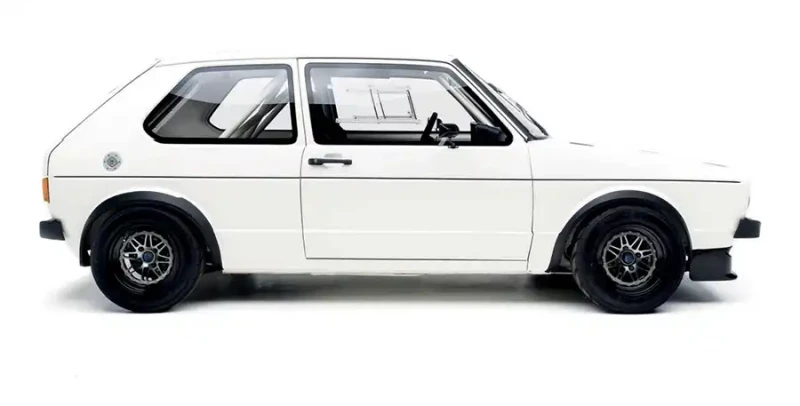
Influenced by a friend with a lowered Mk1 and himself later owning two Mk1 Golfs and a nice Mk1 Jetta coupe (sold to finance this project), Frank caught the motorsport bug at an early stage — “mid 90’s BTCC was the pinnacle” — and knew exactly where his latest project was going: “The idea was to restore the car and rebuild it to a street-legal trackcar and make it as light as possible. This weight calorie counter project took 11 years to complete, but was it worth the weight (stop it! – Ed)?
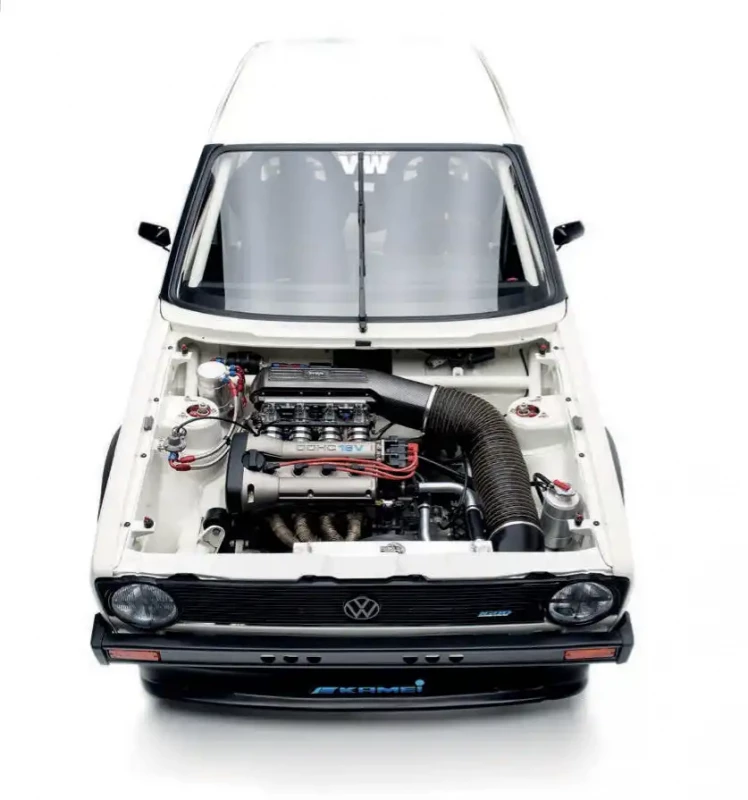
An engineer by training, Frank’s game plan was part Berg Cup inspired (small block engine) and part understated ‘90s BTCC (body): Why a small block? “I was inspired by the Mk1 Golfs and Polos from the Bergrennen in Germany. Very light and nimble, with screaming normally aspirated 1400cc or 1600cc engines. I would love to see that work on a real circuit, especially with the underdog concept behind it. You don’t need big power if you are very light. A 1400 cc Golf pushing BMWs and Porsches — that’s what I wanted!” – but over time this would become 1600cc…
On top of this looks were important, but not outlandish ones: “I really wanted to have the car fairly original looking from the outside, because of the underdog idea, and also because of that BTCC style: low and wide wheels but in an original narrow body style. So no Berg-cup arches and spoiler for me but bumpers, GTI arches, modified as much as I could to be able to go as wide as possible within the standard arches.”

Onto the rotisserie the car went and then the fun began: “After disassembling and removing all the underseal it was clear it was not as rust-free as I thought.” Frank couldn’t weld at the time, but wanted to do as much of the work on this project himself. “I went on a one-day car-welding course and bought myself a MIG welder. The best investment I made in my life.” Word to the wise: this is what ‘Built not Bought’ looks like. “I practiced some more and just started cutting out rust and welding in new metal starting from the front and ending in the back.” A year on with the sheet metal bodywork repairs done, the bodyshell seam welding could begin. A plastic 45-litre Summit Racing fuel cell was sunk as low as possible into the rear seat floor on the opposite side to the driver for centre of gravity and weight distribution, then it was off to VW legend Marco Veldhuis at Marco’s Motorsport for the aforementioned multipoint roll cage installation. CDS tube was used rather than thin-wall T45 and was the one compromised necessity at the time due to sheer cost. To clean the shell up it was then sent for blasting and e-coating in readiness for the dry build to start.
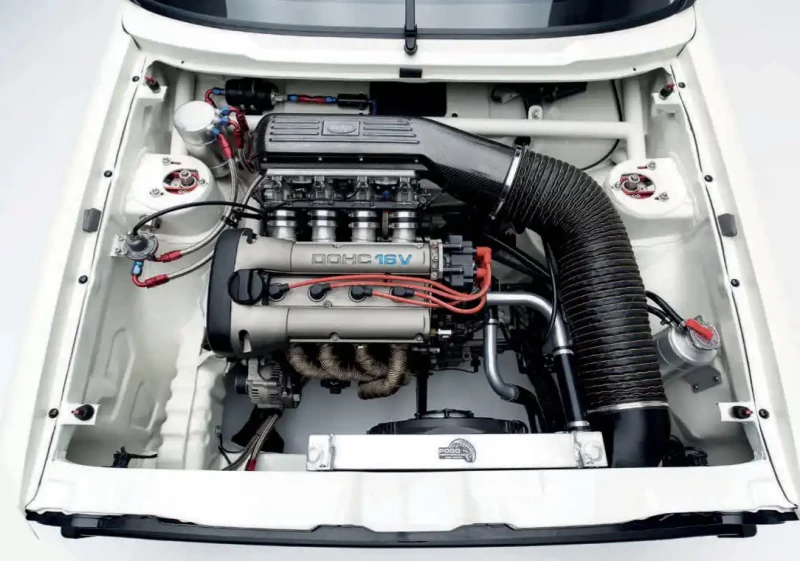
As replacement parts arrived, everything was weighed. Gutting the interior to be replaced by race seats and lightweight door cards is a given and, along with the spare wheel, loses a net 45kg rapidly. Emptying the doors and taking off the inner skin loses 15kg, as does replacement fibreglass bonnet, hatch and front wings. Another 12kg was lost swapping side and rear glass for polycarbonate. Removing interior sound deadening is a necessary evil and ejected a further 7.5kgs. Standard prepping stuff. Surplus interior brackets and rear side panel innards removed another 4kg and 4.5kg went west with the spare wheel well, covered instead with a carbon skin. Metal tow hooks were cut off, and replaced with fabric ones. Scuttle removed. Brake servo and heater in the bin. Underseal removed in the days long before face masks took on a whole new meaning. No stone unturned.
But with each step, the work out gets more and more difficult. Time to think smarter! ”I don’t really like the bumper-less look,” noted Frank. The solution? Rperformance fibreglass bumpers fixed with aluminium brackets. The wheels are another smart move, being around half the weight of any alternative you’d care to think of, from a Campaign Pirelli to Team Dynamics Pro Race 1.2: “I knew I needed stopping power but also didn’t want to go too big, as big brakes are heavier, and need bigger wheels which again are even heavier.” The 256mm brakes just fit inside the 3.5 kg-a-piece 13x7” Force Racing SLD wheels, who are a Mini Racing specialist. Having considered other wheels on the build journey, Frank’s research was exhaustive: “I haven’t found a lighter wheel yet!” This takes another 10 kgs off the running total. Blue hue VW Motorsport logo’d centre caps show the attention to detail. Next up, the oily bits: “The engine is really the party piece of this car. I started this project with a 1.4 8v but realised a 16v would suit better and also be capable of making more power. In the end I built a hybrid of a 1.6 16v Polo GTI 6N2 bottom end with a better-flowing DOHC 1.4 16v AFH head.” The internals were all done by Feld Motorsport in Germany who have a lot of experience with these engines. “I went with Kawasaki ZX12R 46mm tapered ITB's with 47mm trumpets — to save money at first — but they ended up costing more in the end! They do work good now though. The Daihatsu alternator saves a lot of weight too.” Another 2.5kg gone!
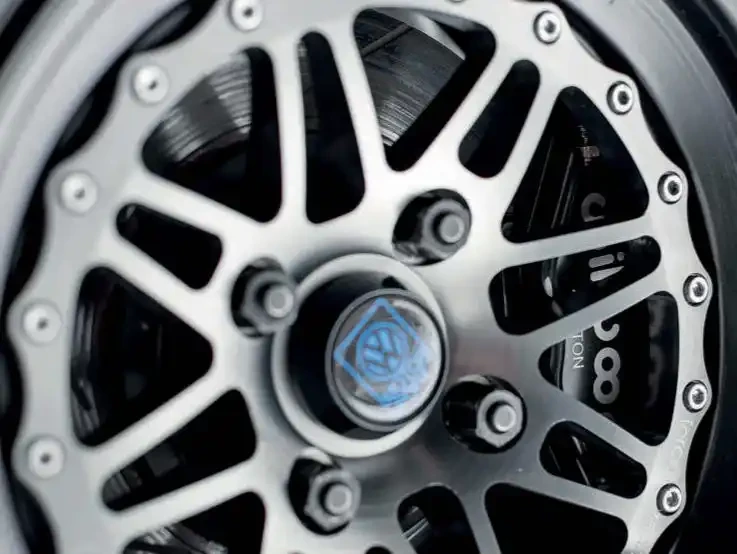
Hurricane racing engines who have a lot of experience with DTA Management mapped the motor and are based close to Frank. “The limiting factor of the engine is the still standard crank as it limits the rpm to 8500rpm, but I just couldn’t afford a bespoke crank. It doesn’t matter: 200+ horsepower in a Golf is just so much fun.” 206 to be exact. With a small-block 085 5-speeder, there’s even more weight saving against conventional Mk1 track builds to be had. Having bench pressed these in my earlier days, these lightweight boxes come in around 5kg under a normal Golf GTI rod change, let alone a cable change. Careful research saw Frank choose a CEH code to get the optimal 3.8 + un-boltable crown wheel (some were fixed) from the Polo parts bin. A shorter fifth gear was fitted to get rid of the factory highway cruiser cog.
Bolting it all into the car, Frank was forced to redesign the gearbox to inner wing mount since these 5-speeders were never fitted in Mk1s. In the end Frank redesigned the front and rear mounts too. Guess what? “To make them stiffer but also lighter without sacrificing strength”! Another 2.3kg gone in conjunction with titanium bolts. The eagle eyed will recognise these artful mounts from grazing the socials (link in Dub Details). “Chassis-wise I looked for high-end parts there were available at the time. The Intrax shocks plus SCCH tubular control arms with lengthened drop pins really help the front end. For the rear I made the rear beam triangulation myself, using a hollow Autotech anti roll-bar to offset some of the triangulation weight gain.” The attention detail stands out: rubber boots over the spherical joints to keep the dirt out. Less obvious are the rear dampers, made out of mostly aluminium…
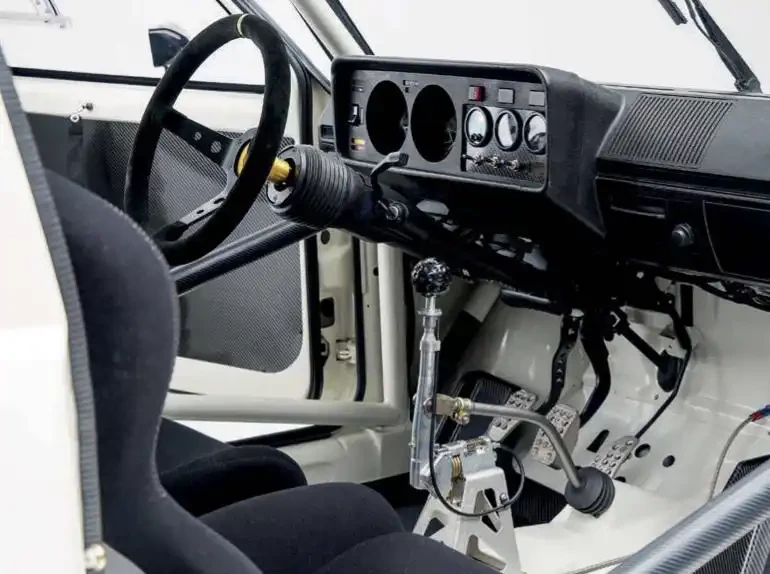
For the interior, Frank’s aims were minimalist and a clean finish: “I kept the dash clocks as I just love it and I wanted to keep that Golf period feel inside the car. Hence also the 52mm gauges. A digital dash would have been lighter but you also lose a lot of the old-skool soul. They are modified to 260km/h and 9,000rpm though.” A lightweight Lithium battery sits behind driver’s seat, saving an incredible 10 kgs in exchange for 100 Euros as well as putting weight in the right place, low and inside the wheelbase. That’s the last double-digit weight saving to be had. From here on in, it’s pure graft.
Once built, and confirmed legal for the road in 2019 by the RDW Netherlands vehicle authority, the process of shaking down could begin. Cue a steady stream of small improvements. With a lot of induction noticed from the Kawasaki trumpets and track day noise meters in mind, a Reverie carbon airbox complete with integral cone filter in the trunking immediately superseded the foam filter. Composite soaks up vital decibels and Frank thinks: “it even sounds better”.
Soon the Mk1 was off to its debut at a late Summer Zandvoort track day. Cue the addition of carbon strips in the bonnet leading edge to stop it bowing upwards, plus an upgraded oil cooler, as well as adjusting the brake set up. Assen circuit was followed by further upgrades including a Gripper plate limited slip diff, plus 3D-printed brake ducts for the front spoiler.
An indiscretion at Zandvoort in Nov 2020 saw a trip to the bodyshop for some minor rear corner repairs and coincided with changes up front: “for the first two years I drove with a GTI front spoiler as well but changed to a Kamei spoiler to help the aerodynamics a bit — which it really does! – whilst keeping the original-era style.” More Winter upgrades included a Polo G40 ‘Pogo’ deeper aluminium radiator, offset to create airbox trunking space for a neat 3D-printed grille air intake.
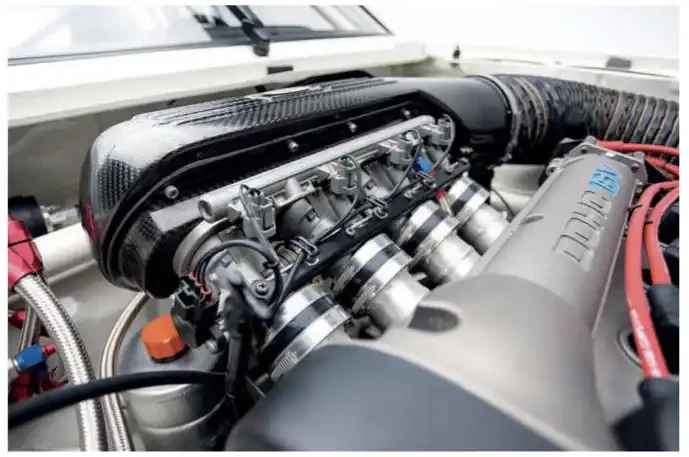
Next up, lightweight Momentum Motorparts two-piece 256mm discs – another 1.3kg saved per side! “The combination including the brake balance system works very well, although brake cooling is really needed as it’s hard to dissipate the heat in this tight setup. The 185mm wide tires are a limiting factor for the car now but also make the car very fun and playful to drive.”
On top of this a Polo rear hub bearing set up was added: “not only a better construction but also 0.5kg lighter per side!”, as well as carbon foot plates replacing aluminium – another 1kg banked!
In 2023, “I changed from Mk1 knuckles to Mk2 knuckles as I broke a drive-flange and CV-joint on track at 150km/h which was exciting…” With lengthened drop pins installed again and the benefit of larger bearings plus the requisite bump steer adjustments, the Mk1 is ready to go again: “I haven’t driven it much last 1.5-2 years because I bought a house which needed quite some work, but it has a garage in which I can work on the Golf! 2024 however will see more track-action again.”
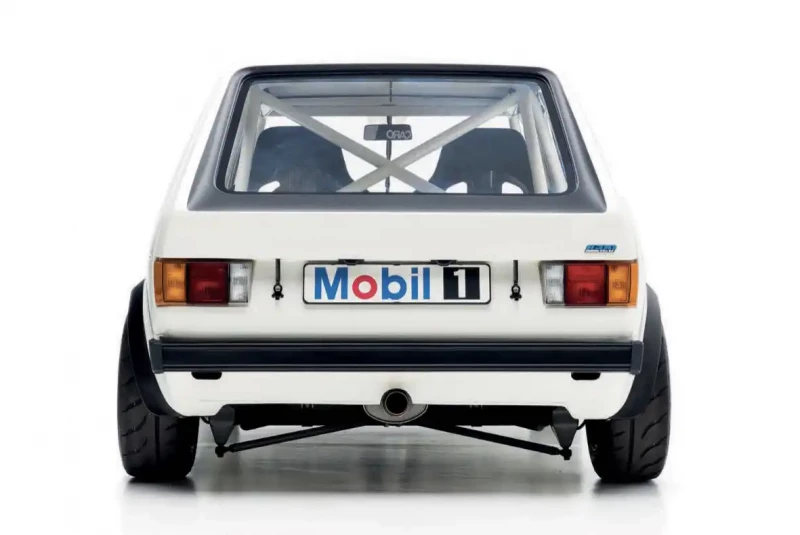
In a car scene dominated by wide body, big bhp builds that shout loudly, Frank’s crisp Arctic White Mk1 is utterly restrained. Even the factory flag mirrors were used for a while but they folded at speed and were replaced with Spa racing versions. But the depth of understated quality, engineering thought and standard of finish stands out a mile here.
This Mk1 does its shouting on track – a sight which never gets old — built to plan and the preserve of a committed mind: “The engine doesn’t do much below 4500-5000 rpm, and because of the small displacement it lacks torque in lower revs. After that it’s all fun, with that Berg-Cup/BTCC scream in your ears. The car is really able to embarrass BMWs, Lotus', Porsches and so on, on track which is just so cool with that original goal in mind. Everything on the car I did myself except the cage, paint, and engine internals. I really took every part and looked if it could be lighter without spending crazy money.”
So with the upshot of all the incremental savings– and indeed — where are we on the ‘math’? Well, 770kgs start-point + 50kg roll cage, less 70kg of parts binned never to return = 750kg. Less 85kgs for lighter replacement parts, seats etc. Plus adding weight where necessary such as the larger AFH head, the 5-speed box, rear axle triangulation etc.
“The goal of 700kg was achieved with 697kg with all fluids except fuel!” – although Frank does concede that the passenger seat and harness has to come out!

Old school readers from the forum days may remember Frank’s Volkforum build thread (‘Project lightweight — Golf 1 trackday auto’). And if you want to check every instalment, there’s 141 pages of it.
Of course, projects just like diets, never end: “My choice was to finish the car, enjoy it and still be able to upgrade the car later on. The roof and doors are still steel. I would like carbon someday — but only in high quality!” That’s growing old gracefully.
DUB DETAILS 1980Volkswagen Golf Mk1
- ENGINE: EA111 Polo 6N2 GTI ARC coded 1,598cc block (76.5mm bore x 86.9mm stroke) and Polo 6N AFH 1.4 16v head, built by Feld motorsport. Mahle forged pistons, H-section steel rods, 12.8:1 compression, balanced VW crank, baffled sump, Setrab 19-row oil cooler, performance-parts.eu oil catch tank with selfdesigned engine block AN-adapters. Polished and ported head, 32mm inlet & 28mm exhaust valves, high lift cams on solid lifters with uprated valve springs, adjustable cam pulleys, modified Danst engineering inlet manifold breathing through Kawasaki ZX12R 46mm tapered ITBs with 47mm trumpets. Reverie Silverstone carbon airbox with 3d printed grille-air intake. Supersprint 4-2-1 exhaust manifold, 2.5" self-built exhaust. Daihatsu lightweight alternator with large pulley to reduce speed. Pogo performance radiator, Spal-fan, performance-parts.eu custom cooling expansion tank. Facet red-top low pressure fuel pump, Walbro GSL392 high pressure fuel-pump, Malpassi adjustable fuel pressure regulator, performance-parts.eu swirl pot. Fabricated distributor delete & coil pack mounting plate, Magnecor plug leads, DTA S60 engine management system mapped by Hurricane racing engines: 206 hp at 8,000rpm & 198 Nm at 5,900 rpm. Polo CEH 085 5-speed gearbox with shorter 5th gear, Gripper plate differential, Sachs performance clutch, gearbox and engine mounts redesigned for lightness and stiffness. Shortened drive shafts with 90mm outer CV joints
- CHASSIS: Force racing wheels SLD7 7x13 ET5 (with 5mm spacers on front axle), wheel studs and aluminium nuts, Toyo R888R 185-60-13 track tyres. Intrax 1K2 inverted coilover dampers, Intrax camber plates. Mk2 Golf front hubs adapted for mk1 dampers, complete with SCCH tubular control arms, spherical drop pins (roll centre bump steer kit). Rear SCCH rear beam spherical bearings, fabricated rear beam toe stabilizer kit, Autotech hollow anti roll bar. MMP (Momentum Motor Parts) lightweight 2-piece 256mm discs with Wilwood 4-pot front Powerlite calipers with MMP adapters, Polo 6n2 GTI rear stub axles, hubs and discs with Mk4 38mm aluminium calipers and standard pads. Compbrake bias pedal box with Wilwood master cylinders, Tilton brake bias adjuster, Goodridge braided brake hoses, Wilwood BP40 pads, cooled via 3D-printed adapters from front spoiler to brake cooling ducting. Quaife quick rack, 24Racesupport aluminium rack clamps
- EXTERIOR: 1980 Mk1 Golf 1.3. All underseal and unnecessary brackets removed. Scuttle removed. Fully seam welded, Smith & Deakin fibreglass bonnet with Aerocatch hood latches, wings and tailgate. Rperformance fibreglass bumpers with fabricated aluminium brackets. Rear valance raised and modified for centre exhaust exit. Lancia Y10 single wiper, P4P lexan windows, Spa touring car mirrors. VWMS custom centre caps. Smoked crosshair headlights, Kamei front spoiler, aluminium quick release tank cap, widened and trimmed wheel arch edges, GTI arches and A-pillar trims. Renewart custom emblems. Painted in L902 Arctic White. 697kg total weight with one passenger seat, harness and fluids except fuel
- INTERIOR: Marco’s Motorsport multi-point roll cage, FIA roll cage padding, period VW dash clocks modified to 260km/h and 9000rpm, Stack 52mm gauges (oil pressure, oil temp, coolant temp), Zeitronix ZT-3 Wideband Air Fuel Ratio Meter and display, Recaro Profi SPG XL seats, Willans Silverstone LDV6 harnesses, OMP Corsica Superleggero steering wheel with Lifeline quick-release hub, lowered steering column. CAE shifter with original VW-motorsport gearknob. OMP pedals, Carbontec foot rests, carbon door and rear quarter cards, door opening pull straps. 1kg Lithium battery behind driver’s seat, with kill switch next to seat. 45 litre Summit racing fuel tank with fabricated aluminium cover. Spare wheel well removed and replaced by carbon plate, Campus drinking cup washer fluid bottle, Lifeline fire extinguisher
- SHOUT: My parents for using part of the garage and tools for so long! My girl Melanie for all the times I was working in the garage again, MMP Momentum Motor Parts, Feld Motorsport, Hurricane Racing Engines, 24racesupport, Autoschade Stoop, Instagram: @085mk1gearboxmount, Instagram: @knarfmk1, Youtube: knarfmk1
«I didn’t want to go too big, as big brakes are heavier, and need bigger wheels»


